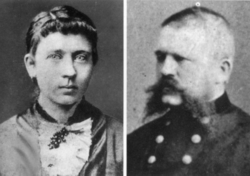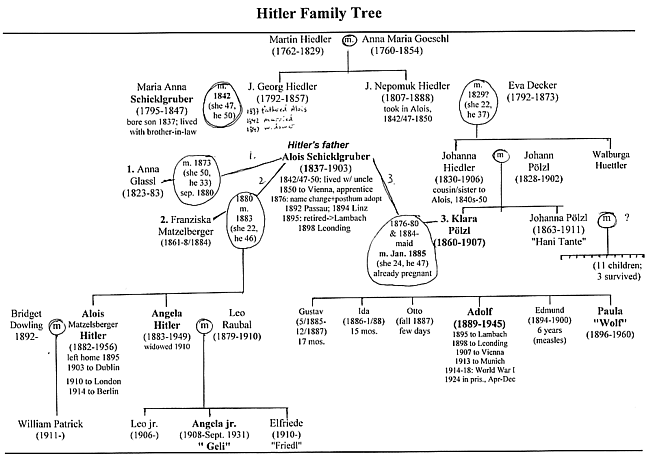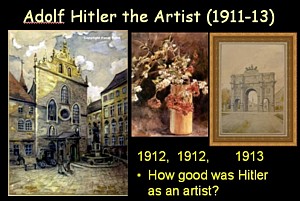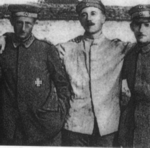|
1.
Primary Sources: How do we know about Hitler's life? (back
to top)
This section began with an analysis of document 2 in the textbook (Engel
2000, 89f): Hitler's August 13, 1920 speech "about the Jews."
I read the excerpt aloud in class and pointed out how historians interpret
this passage to mean that Hitler, from this early date, wanted to murder
all Jews (Engel, 15). I then produced a thick collection of documents,
Hitler's Complete Writings, 1905-1924, edited by Jäckel
and Kuhn (Stuttgart, 1980), which reproduces the entire 3-hour speech
on pp. 184-204. It contains valuable additional information that enables
us to better assess this document.
A poster announcing this meeting of the NSDAP on a Friday night in the
Hofbräuhaus in Munich titled the speech "Why are we antisemites?"
We have the handwritten text of the speech (with a few minor edits in
Hitler's hand), as well as a police report and several newspaper reports,
including the anti-Nazi Munich Post and the Nazi paper Völkischer
Beobachter (National Observer).
There is no doubt that this is a murderously antisemitic harangue. At
the same time Hitler's calls for death as the solution of the presumed
threat posed by Jews are embedded in a detailed explanation of a racial
worldview that addresses and attempts to refute many pro-Jewish standpoints.
It is not a simple matter to connect this racist vision put forth by a
minor figure in a provincial capital with a grandiose continental plan
for genocide implemented with the resources of a major industrial nation.
This is not Hitler's first documented theoretical statement about Jews.
In September 1919 his Reichswehr boss asked him to answer a letter from
a certain Adolf Gemlich asking why "Jewishdom" posed such a
danger (see Jäckel and Kuhn, 88-90; translation
on H-German). At that time Hitler's supervisor already knew that Hitler
was a passionate "expert" on the "Jewish question."
So, what are the sources that document Hitler's early life?
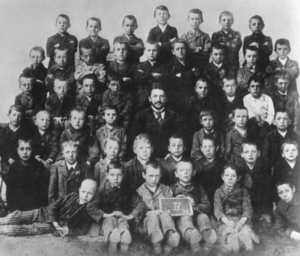
Hitler's 4th
grade class in Leonding, 1899 (AH top center): Predestined to lead?
|
- Hitler's own autobiography, Mein Kampf (My
Struggle), written in 1924, supplemented by stories he told to
his inner circle in the 1940s that were recorded by a stenographer and
published after the war (variously known as Hitler's "Table Talk"
or "Secret Conversations." We know that Hitler deliberately
distorted and misdated some events in order to present to his followers
a straighter line of predestination to lead Germany.
- The full
text in English of Mein Kampf is available on the web.
Chapters 1, 2, 4, 5, 7, 8 are the most relevant autobiographical
ones.
- Four deliberate falsifications:
- Adolf's relationship to his 52-year-older father;
- How poor he was in Vienna from 1908 to 1913,
and how hard he worked while there;
- Whether his (antisemitic) "world view"
formed in Vienna
- The date of his move from Vienna to Munich (May
1913, not 1912)
- Memoirs of people who knew him, for instance:
- August "Gustl" Kubizek, his best friend in Linz and Vienna
(fall 1905-fall 1908), who wrote his reminiscences for the NSDAP archive
in 1938. He published a book in English in 1954 (republished in 1973):
Young Hitler: The Story of Our Friendship translated by E.V.
Enderson, introduction by Hugh Trevor-Roper (London: Allan Wingate,
1954). Although Kubizek boosted his memory by plagiarizing from Mein
Kampf, he does add valuable insights.
- Paula Wolf, Hitler's
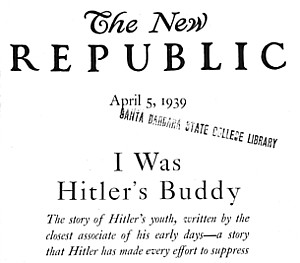 younger
sister, who was interviewed by US Army intelligence in June 1945 and
July 1946. (full texts available on Michael
Williams' website) younger
sister, who was interviewed by US Army intelligence in June 1945 and
July 1946. (full texts available on Michael
Williams' website)
- Reinhold Hanisch, who lived and worked with Hitler in the homeless
dormitory in Vienna around 1910, and Karl Honisch, another resident
of the dormitory who knew Hitler in 1913. Hanisch published his story
in 1939 in the New Republic under the title "I Was Hitler's
Buddy" (scans
and text available here); Honisch wrote his for the NSDAP archive
in the 1930s.
- The memoirs of Hitler's fellow messengers in World War I, for example:
Balthasar Brandmayr, Meldegänger Hitler 1914-18 (Munich,
1933), and Ernst "Schmiedl" Schmidt.
- Official documents about Hitler's life, such as birth
certificates, police apartment registry entries, draft board proceedings,
bank records, military regimental assignment and pay records, police
reports, court records.
- Personal documents, including letters Hitler wrote
to friends and acquaintences, photographs, drawings and paintings.
- Oct. 1914-Feb. 1915: letters to his Munich landlords, Anna &
Josef Popp
- Feb. 5, 1915: 12 page letter to Ernst Hepp in Munich, who had
bought several of Hitler's paintings and knew him personally.
- Portions of the letter to Hepp were reprinted
in Nazi newspapers between 1937 and 1945.
- reprinted in Jäckel and Kuhn 1980, 64-69.
- Public media, such as newspaper reports, photographs
and even films.
(see 2002
UCSB student paper on Munich Post)
- Biographies of Hitler, especially those written during
his lifetime, by journalists and scholars who, in addition to using
the documents above, interviewed people who know Hitler.
- Rudolf Olden, Hitler the Pawn (London, 1936)
- Konrad Heiden, Hitler: A Biography (London, 1936); Der
Führer (London, 1944)
- John Toland (1976): journalist interviewed more than 160 people
in 1963 and 1970s.
- We have an especially rich collection of everything because the Nazi
party chancellory collected everything it could in the 1920s, even commissioning
memoirs from people who had known Hitler at various stages of his life.
(Issue of questionable documents: Lukacs 1997, p. 59ff)
|
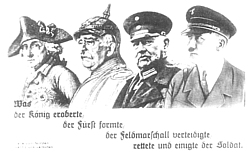
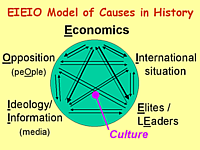 I
argued that the causes of any historical event can be categorized as follows:
Economic factors (for simple societies, this is the Environment)
are usually the primary movers (this is the basic postulate of Marxist
historiography). International factors, the role of Elite
groups and particular LEaders, the prevalance of certain
Ideological world-views and the availablity of (true
or false) Information, and the choices made by individual
peOple (especially when in Opposition
to economic motivators, elite guidance, ideological spin, or international
pressures), all combine to yield a particular historical outcome. The
precise way these factors combine is shaped by the arena of Culture,
which determines how each factor interacts with the others.
I
argued that the causes of any historical event can be categorized as follows:
Economic factors (for simple societies, this is the Environment)
are usually the primary movers (this is the basic postulate of Marxist
historiography). International factors, the role of Elite
groups and particular LEaders, the prevalance of certain
Ideological world-views and the availablity of (true
or false) Information, and the choices made by individual
peOple (especially when in Opposition
to economic motivators, elite guidance, ideological spin, or international
pressures), all combine to yield a particular historical outcome. The
precise way these factors combine is shaped by the arena of Culture,
which determines how each factor interacts with the others.
 younger
sister, who was interviewed by US Army intelligence in June 1945 and
July 1946. (full texts available on
younger
sister, who was interviewed by US Army intelligence in June 1945 and
July 1946. (full texts available on 